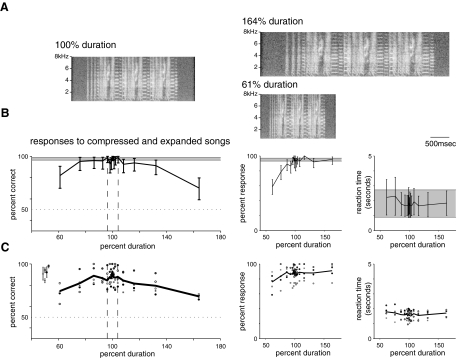Fig. 4.
Responses to songs with altered duration. A: examples of songs with altered duration. Left: unaltered song. Top right: same song expanded by 64%. Bottom right: same song compressed by 64% (duration = 1/1.64 or 61%). Expansion or compression alters the duration of both syllables and intervals but does not change their relative durations nor the frequency content of the song. Duration probes were presented at low probability between unaltered training trials and were rewarded without regard to the female's response. B: performance of 1 bird on duration probe stimuli. Left: percent correct as a function of song duration (—). Error bars and  as described in the legend for Fig. 3B. - - -, the range of natural variability in individuals' song durations (±4%). From 76 to 132% duration the bird's performance on probes overlaps with her performance on control trials, and she performs significantly above chance on all probes. Middle: percent response as a function of song duration. Response rates for probes were comparable to response rates for control trials except for the most compressed songs. Right: reaction time as a function of duration. Reaction time generally did not increase with song duration. C: responses of the same 5 birds to probe stimuli with altered durations. All symbols as in Fig. 3C. Left: percent correct as a function of probe song duration. All birds performed significantly above chance for all duration probe stimuli, although their performance decreased below control levels for the largest changes (61 and 164% duration). Middle: percent response as a function of song duration. Many birds showed a small decrease in response rate only to the most compressed (61% duration) stimuli. Right: reaction time as a function of song duration. Most birds showed no change in reaction time with changes in song duration.
as described in the legend for Fig. 3B. - - -, the range of natural variability in individuals' song durations (±4%). From 76 to 132% duration the bird's performance on probes overlaps with her performance on control trials, and she performs significantly above chance on all probes. Middle: percent response as a function of song duration. Response rates for probes were comparable to response rates for control trials except for the most compressed songs. Right: reaction time as a function of duration. Reaction time generally did not increase with song duration. C: responses of the same 5 birds to probe stimuli with altered durations. All symbols as in Fig. 3C. Left: percent correct as a function of probe song duration. All birds performed significantly above chance for all duration probe stimuli, although their performance decreased below control levels for the largest changes (61 and 164% duration). Middle: percent response as a function of song duration. Many birds showed a small decrease in response rate only to the most compressed (61% duration) stimuli. Right: reaction time as a function of song duration. Most birds showed no change in reaction time with changes in song duration.

